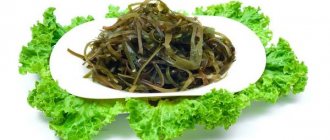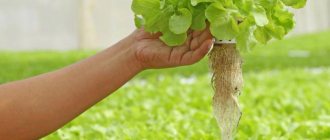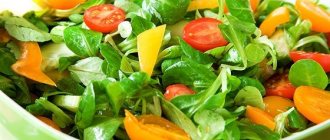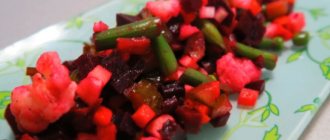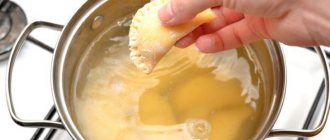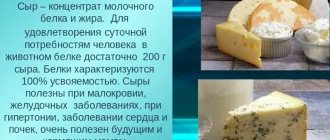Every family, from time to time, prepares a very tasty vegetable salad - vinaigrette. In order to dress the salad, different sauces are used - from ordinary vegetable oil and mayonnaise, to complex dressings with vinegar and spices. The dish can be considered one of the main 5 salads that are prepared regularly in Russia.
For a daily diet, especially in winter, the dish can be an excellent addition with a lot of vitamins and fiber. But what is the calorie content of vinaigrette in one serving? It is not difficult to calculate; ultimately, everything will depend on the ingredients included in the salad and what the dish will be dressed with. Let's try to understand this issue in detail.
Interesting! The dish got its name from a French vinegar-based sauce called “vinaigrette,” and the salad came to Russia around the end of the 19th century, and was borrowed from the Germans and Scandinavians.
Before this, in Rus' they preferred to eat all the ingredients separately, but with the appearance of an “overseas” cook in the kitchen of Alexander the First, who asked about the sauce with which they would be served, and whether vinegar would be included in it, the name was firmly stuck to the dish.
Useful properties of vinaigrette
This cold appetizer, in principle, can be classified as a dietary dish, provided, of course, that certain preparation conditions are met. The advantage of the salad is that 90% of it uses seasonal vegetables for preparation and light dressings. But a high-calorie salad can also be prepared by adding fatty herring and a large amount of sauce. At the same time, the classic vinaigrette has proven itself well as a dietary dish; there is even a special diet based on this salad.
The main ingredients included in the composition have such positive effects on the human body as:
- The level of “bad” cholesterol in the blood is noticeably reduced;
- Improves human metabolism and metabolic processes in the body;
- Due to the high content of vitamins, vitamin deficiency does not develop and the natural human immunity is strengthened;
- Due to the high fiber content in the composition, digestion and functioning of the gastrointestinal tract improves.
The classic vinaigrette includes the following ingredients:
- Boiled vegetables - beets, potatoes and carrots;
- Onions or green onions (sometimes pre-pickled);
- Pickled cucumbers and sauerkraut;
- Fresh herbs;
- Oil and vinegar dressing.
Various recipes suggest adding other ingredients, such as green peas and beans, but not everyone loves legumes. For holiday options, it is suggested to add herring and milk, red fish, and capers for piquancy.
Beets can also be used in different varieties for cooking - the final color of the salad will depend on its color. But as a rule, salads are decorated with greens when serving, only the feathers of green onions are used for cooking (often, instead of hot onions).
To preserve the beneficial properties in the dish, experts suggest following tips such as:
- Do not boil vegetables, but steam or bake them. Even if potatoes and carrots are boiled, it is recommended to cook them in their “uniform” and not for a long time.
- If you plan to add peas or beans to the salad, it is recommended to use them fresh, instead of canned vegetables. It is enough to simmer young peas and green beans in boiling salted water for a couple of minutes so that they have time to become ready.
Diet salad recipe
To prepare a dietary salad, it is not necessary to remove potatoes and vegetable oil from its composition.
The main rule is moderate consumption of vinaigrette. People get fat not from high-calorie foods, but from their increased amount in the diet.
Olive oil is better absorbed by the body than sunflower oil, so in recipes these two ingredients are interchangeable. It also enhances fat burning.
To prepare two servings of vegetable salad you will need:
- potatoes - 2 pcs.;
- beets - 2 pcs.;
- carrots - 2 pcs.;
- canned green peas or boiled beans - 2 tbsp. l.;
- oil - 2 tbsp. l.;
- fresh herbs (dill, green onions);
- onion - 1 pc.;
- salt - to taste.
Cooking method:
- 1. Boil vegetables in their skins and cool in the refrigerator so that they do not stick together during the cutting process.
- 2. Peel potatoes, carrots and beets and cut into cubes.
- 3. Season the beets with 1 tbsp. l. oil so that the vegetable retains its rich color.
- 4. Finely chop the onion and herbs.
- 5. Combine all ingredients, add salt. Add oil and mix well. Salad ready!
What is the calorie content of vegetable vinaigrette?
Depending on the chosen recipe, the calorie content of the vinaigrette will depend, but on average 100 g. The prepared and dressed salad contains about 135 Kcal. That is why it is considered a dietary dish, because vegetables are a filling product that gives you a feeling of fullness for a long time, and extra pounds are not deposited on the waist.
How many calories are in salad with potatoes and vegetable oil?
Traditionally, this vinaigrette recipe is usually flavored with oil and apple or wine vinegar. The calorie content of such a vinaigrette will be approximately 150 Kcal per 100 grams.
However, it is worth noting that you can diversify the dish by using different oils for dressing, each of which will bring its own significant benefits to the body:
Thanks to such a variety of oils, the usual salad acquires new tastes and aromas, piquant nuances. And if you listen to the advice of nutritionists, then the vinaigrette can be prepared very tasty, low-calorie, and it will bring maximum benefits to your body. Thanks to the oil, the products will not only retain freshness, but also increase its energy value and usefulness.
No added potatoes
Some recipes suggest excluding potatoes from the ingredient list, and in some cases this actually benefits the salad. For example, for serving a dietary dish, or in cases where the vinaigrette is offered as an addition to mashed potatoes and cutlets.
Then it is recommended to add green peas or beans to the dish, but you should dress such a salad not with ordinary, but with “interesting” oil, although you can also use sunflower oil that smells like seeds (unrefined).
The total calorie content will be approximately 55 Kcal per 100 g. portions.
With green young peas
Green peas, in addition to benefits and vitamins, contain easily digestible vegetable protein, a large amount of vitamins and microelements. Due to its diuretic effect, peas have a very good effect on the human kidneys and liver.
You can prepare the dish with both fresh and canned products. It is enough to blanch the frozen product for a couple of minutes in hot water.
The total calorie content will be approximately 112 Kcal per 100 g. portions.
With sauerkraut
Some vinaigrette recipes call for adding sauerkraut instead of cucumbers. And many housewives use both ingredients for cooking, then the salad turns out “light”, with a pleasant piquant sourness.
If the cabbage was prepared according to all the rules, without adding vinegar, then it can also be added to the dietary version of the salad. After all, it is sauerkraut that is so rich in vitamins and microelements in the winter season.
The total calorie content will be approximately 108 Kcal per 100 g. portions.
With added beans
As an additional ingredient, or as a replacement for potatoes, beans are often added to the salad, which are incredibly rich in vegetable protein. And the variety of varieties of this legume will provide a choice even for the taste of a gourmet.
Regardless of the variety and type of beans, they are equally beneficial for the human body, and you can use beans, or cut boiled green beans into the same cubes as other products.
The total calorie content will be approximately 56 Kcal per 100 g. portions.
With the addition of lightly salted herring
In Scandinavian cuisine, where this dish came from, vinaigrette is usually prepared with the addition of Norwegian herring. Spicy-salted cold-salted fish goes perfectly with potatoes and beets, which gives the dish a very appetizing note.
To prepare a salad, experienced chefs recommend soaking the herring in milk before cooking, because this will remove excess salt from the product and make the herring more delicate in taste.
The total calorie content will be approximately 125 Kcal per 100 g. portions.
Calorie content of vinaigrette without adding oil
Not only experienced chefs, but also nutritionists disagree on whether it is worth adding vegetable oil to the vinaigrette. Nutritionists say that by abandoning the oil dressing, the calorie content of the vinaigrette can be reduced to 50 Kcal per 100 grams. a portion of salad. But the chefs insist that the dish simply needs a flavorful dressing.
Of course, it’s up to you to add butter to the dish or not, but even a regular sauce can be pleasantly varied by using sauces such as;
The total calorie content will be approximately 38 Kcal per 100 g. portions.
With added mayonnaise
One of the most high-calorie salads is with mayonnaise sauce. If you still choose just such a dressing, it’s worth spending an extra 5-7 minutes on preparation and making your own mayonnaise based on chicken yolks.
You can use the whole egg, or replace it with quail eggs, add aromatic sunflower or olive oil, grain mustard and lemon juice. This sauce will not contain dyes, flavor enhancers or other additives.
The total calorie content will be approximately 228 Kcal per 100 g. portions.
With mushrooms
As strange as it may sound, some salad recipes involve adding salted or pickled mushrooms instead of cucumbers and sauerkraut. The vinaigrette with the addition of mushrooms is hearty, piquant and incredibly tasty.
But there is one very important note - it is recommended to cut all the ingredients for the dish into very small cubes, and prepare the salad in small portions, since the mushrooms release a decent amount of liquid.
The total calorie content will be approximately 135 Kcal per 100 g. portions.
Calorie content of traditional salad products
A person who, for health reasons or to have a good appearance, is concerned about losing weight can create his own vinaigrette recipe. The energy value of the main and most often found products in this dish is as follows - the numbers are indicated per 100 grams in kilocalories:
- Boiled potatoes – 78;
- Boiled beets – 40;
- Boiled carrots – 35;
- Pickled cucumbers – 15;
- Sauerkraut – 25;
- Peas – 54;
- Boiled beans – 250;
- Salted mushrooms – 26;
- Lightly salted herring – 160–218;
- Sunflower seed oil – 900;
- Mayonnaise – 680.
Nutritionists estimate the calorie content of the vinaigrette, which is prepared from the above products with potatoes and sunflower seed oil, at 120 kcal per hundred grams of the dish, and 50% comes from the dressing. Thus, those who are forced to watch their weight need to think about whether to eat the vinaigrette with an oil dressing, or simply pour it with lemon juice or sprinkle it with vinegar.
About the composition and nutritional value of vinaigrette
The overall balance of a dish can vary depending on what ingredients are added to the vinaigrette, so it is difficult to determine the exact ratio of fat, protein and carbohydrates.
Therefore, let’s take an average example of cooking, with and without vegetable oil, in order to become more familiar with the general indicators. The composition of all salads is the same, according to the classic recipe, with pickles and potatoes.
General balance with vegetable oil per 100 g. portion of vinaigrette:
- Fat – 11 gr.;
- Carbohydrates – 9 g;
- Protein – about 3 grams.
From these indicators it turns out that the dish has a high calorie content, the amount of fat is about 14% of the daily human consumption.
General balance without vegetable oil per 100 g. portion of vinaigrette:
- Fat – 0.35 g;
- Carbohydrates – 8.9 g;
- Protein – 0.37 g.
In such a vinaigrette, there is practically no fatty residue, which makes the dish dietary and very healthy. And this almost removes the restriction on its consumption during the day and the size of portions.
But here there is a small aspect that I would like to draw attention to. Fat-soluble vitamin A, which will not be absorbed without vegetable or animal fats, so it’s still better to season the salad a little with oil, just reduce its volume several times.
Potatoes – to be or not to be in vinaigrette
Traditionally, after beets in terms of the number of ingredients in the total volume, potatoes take second place in this salad. This begs the question - is it possible to eat it without potatoes, will it be tasty? The dish got its name thanks to a foreign language - formed by two French words, the name translated means a mixture of vinegar with - this is a dressing for boiled vegetables with pickles. Therefore, the salad has the right to be without potatoes.
Green peas can replace potatoes. To make the salad even more dietary, high-calorie sunflower seed oil can be replaced with flaxseed oil - you only need one or two spoons of it for a large dish. The calorie content of one hundred grams of a dish without potatoes will be only 49 kcal, which means that the salad can be recommended if it is necessary to follow a low-calorie diet.
About beneficial properties
The vegetables that make up the salad do an excellent job of saturating the body with vitamins and minerals. Vinaigrette contains 18 of the 20 elements a person needs for full health and well-being. And how much dietary fiber and plant fiber are in vegetables, which cleanse the gastrointestinal tract and the body, having a beneficial effect on the intestines and digestion.
So, if we draw simple conclusions, then vinaigrette saturates the body with protein and vitamin food with a high content of minerals and fiber and has a very beneficial effect on the human body as a whole.
Chefs believe that a true vinaigrette should not be evenly colored by the beets. To avoid this, after the beets are chopped, they should be seasoned with vegetable oil in a separate bowl.
The proportions for cooking are selected individually by each housewife (to the taste of all family members).
Salt does not dissolve well in oil, so they try the dish (after all, it already contains pickled cucumbers and cabbage), then, if necessary, add salt, and only then season it.
The beets for preparing the vinaigrette should be bright red, in no case the fodder varieties. If the root vegetable turns out to be unsweetened, then the chopped cubes can first be sprinkled with granulated sugar, and as soon as it dissolves, add sunflower oil.
The most delicious vinaigrette is obtained if the vegetables are equally cut into small cubes, no larger in size than the kernel of green peas. But you shouldn’t be overzealous, otherwise you may end up with vegetable porridge instead of salad.
You should not store a seasoned vinaigrette with quickly oxidizing foods (cabbage, cucumbers, mushrooms) in the refrigerator for a long time. The maximum period is no more than a day.
Before serving, the finished salad should be refrigerated for a couple of hours, then it will infuse and all the ingredients will be saturated with other flavors and aromas from the dressing.
You will find the recipe for a delicious classic vinaigrette in the following video:
No matter what recipe the vinaigrette is prepared according to, this salad will always remain popular both for a festive feast and for everyday meals. In addition, there are practically no strict rules for preparation, and if you don’t have some minor ingredient on hand, then nothing bad will happen. You can always smile and answer that this is such an interesting and extremely popular, new recipe for your favorite vinaigrette.
It is hardly possible to meet a person who does not know what vinaigrette is. This popular salad, named after the French hot sauce based on vinegar, appeared in Russia around the 19th century, and it probably came to us from Germany or one of the Scandinavian countries. The main feature of this salad is its availability and low calorie content, which allows it to be called a dietary dish. To prepare the vinaigrette, seasonal vegetables are used, each of which contains a large amount of useful minerals and vitamins. There are a huge number of salad recipes, so it is difficult to say exactly how many calories are in the vinaigrette; to do this, you need to familiarize yourself with the calorie content in each salad ingredient.
With or without vegetable oil?
Having prepared this dish from products from the above list, but without sunflower seed oil, 100 grams will contain 44 kcal. This salad is considered dietary. And if you also remove potatoes from it, then you can eat as much vinaigrette as you like without damaging your figure, because its calorie content will be only 35 kcal.
If the dish contains butter and peas, but does not put potatoes in it, then the calorie content versus 120 kcal per hundred grams with these three ingredients will drop to 95–100.
But a dish without oil may seem too dry. Therefore, for those who follow a gentle diet against and for weight loss, it makes sense to replace sunflower seed oil, the energy value of one hundred grams of which is 900 kcal, and 135 kcal in a tablespoon, with vegetable oils of a different origin.
Many oils not only contain fewer calories, but also provide more health benefits:
- Corn – helps burn subcutaneous fat deposits;
- – helps to subside and stop inflammatory processes in the body;
- Mustard - dishes with it retain their freshness longer, since mustard has a preservative effect;
- Flaxseed – rich in fatty amino acids; in addition, it is also used sparingly - since it has a bitter taste and a characteristic taste of fish oil, it is used less than any other vegetable oil;
- Various nut oils - they have a healing effect on the liver, which is an additional advantage in maintaining health and well-being while following a diet;
- Sesame and pumpkin oils - they are, respectively, rich in calcium and.
During the period of dieting, a person does not leave the desire to eat both tasty and varied. Therefore, a vinaigrette consisting of a number of products, thanks to the spiciness due to the pickles present in it, may turn out to be the very dish that you will not get tired of, no matter how much you eat, and turns out to be not only healthy, but also dietary due to its low calorie content.
Your feedback on the article:
Vinaigrette is a salad that most housewives love and know how to prepare. Of course, every lady has her own interesting recipe for a familiar snack: some add sauerkraut to the salad, others add beans, and still others, in general, add seaweed.
There can be many variations in preparing a familiar dish, but for beauties who watch their figure, it is important to know the calorie content of the vinaigrette. Otherwise, even a small portion of salad can negatively affect your weight loss process. Therefore, it is important to choose from the variety of recipes the one that contains the fewest calories.
Composition, preparation and benefits of vinaigrette
As already mentioned, there are a large number of salad recipes, including a Scandinavian recipe with herring, sometimes red fish and quail eggs are added to it, but for us the vegetable recipe is more common. It can serve as a decoration for a holiday table, it is included in the regular diet, there is even a special diet based on vinaigrette, which gives good results. In addition, vinaigrette is a good way to organize fasting days, especially after a big feast.
The composition of the classic vinaigrette, which we have all become accustomed to since childhood, includes boiled potatoes - a good source of starch, and beets, thanks to which the salad takes on an attractive appearance. In addition, beets help reduce the normalization of blood pressure and have other beneficial properties; the vegetable vinaigrette also includes boiled carrots, rich in carotene, and sauerkraut, which contains a large amount of ascorbic acid and helps improve the functioning of the gastrointestinal tract. Legumes, such as beans or green peas, are a good source of vegetable protein, but the main component of the vinaigrette is vegetable oil, rich in polyunsaturated fatty acids and vitamins.
By the way, to answer the question of how many calories are in a vinaigrette with butter, you should know that butter is the main supplier of calories in this salad. If you want to lose weight, you can experiment with dressings, and the same can be done with other ingredients. Vegetable oil can, for example, be replaced with cabbage brine or use another dressing, and if you look at how many calories are in a vinaigrette with potatoes and compare these numbers with a salad prepared without it, the difference will be noticeable. To make the salad less high in calories, you can also replace sauerkraut with seaweed, which contains, among other things, a large amount of iodine; you can increase the benefits of the vinaigrette by eliminating legumes or replacing canned peas with boiled frozen ones.
Nutritional value and health effects
Potatoes are underground tubers that grow on the roots of the potato plant Solanum tuberosum.
It is a plant from the nightshade family, related to tomatoes and tobacco.
The potato, native to South America, was introduced to Europe in the 16th century and there are now countless varieties grown throughout the world.
They are usually eaten boiled, baked or fried and are often served as a side dish or appetizer.
Common potato-based products and foods include French fries, potato chips, and potato flour.
This article tells you everything you need to know about potatoes.
Boiled potatoes with their skins are a good source of many vitamins and minerals such as potassium and vitamin C.
Besides their high fresh water content, potatoes are primarily carbohydrates and contain moderate amounts of protein and fiber, but almost no fat.
The nutrients contained in 2/3 cup (100 grams) of boiled potatoes, cooked with skins on but without salt, are (1):
- Calories: 87
- Water: 77%
- Protein: 1.9 grams
- Carbohydrates: 20.1 grams
- Sugar: 0.9 grams
- Fiber: 1.8 grams
- Fat: 0.1 grams
Carbohydrates
Potatoes are primarily made up of carbohydrates, mainly a form of starch. Carbohydrate content ranges from 66–90% of dry weight (2, 3, 4).
Simple sugars such as sucrose, glucose, and fructose are also present in small amounts (5).
Potatoes typically rank high on the glycemic index (GI), making them unsuitable for people with diabetes. The GI measures how foods cause blood sugar levels to rise after a meal.
However, some potatoes may be in the average range, depending on the variety and cooking methods (6, 7).
Refrigerating potatoes after cooking can reduce their effect on blood sugar and lower their GI by 25–26% (8, 9).
Fibers
Although potatoes are not a high-fiber food, they can provide an important source of fiber for those who eat them regularly.
The highest amount of fiber is found in the skin, which makes up 1-2% of the potato. In fact, the dried skin is about 50% fiber (10).
Potato fibers, such as pectin, cellulose, and hemicellulose, are mostly insoluble (11).
They also contain varying amounts of resistant starch, a type of fiber that feeds good bacteria in the gut and improves digestion (12).
Resistant starch may also improve blood sugar control by curbing the rise in blood sugar levels after meals (13).
Compared to hot potatoes, chilled potatoes contain higher amounts of resistant starch (8).
Protein
Potatoes have a low protein content, ranging from 1–1.5% fresh to 8–9% dry (10, 14).
In fact, compared to other common food crops such as wheat, rice and corn, potatoes have the lowest amount of protein.
However, the protein quality in potatoes is very high for plants—higher than that of soybeans and other legumes (10).
The main protein in potatoes is called patatin, which can cause allergic reactions in some people (15).
SUMMARY Carbohydrates are the main dietary component of potatoes. Cooled after boiling may contain resistant starch, which improves gut health. Potatoes also contain small amounts of high-quality protein.
Potatoes are a good source of several vitamins and minerals, particularly potassium and vitamin C.
Levels of some vitamins and minerals drop during cooking, but this decline can be minimized by baking or boiling them with the skin on.
- Potassium. Potassium, the predominant mineral in potatoes, is concentrated in the skin and may benefit heart health (16, 17).
- Vitamin C: The main vitamin found in potatoes, vitamin C is significantly reduced by cooking, but leaving the skin on seems to reduce this loss (16).
- Folic acid. Folic acid, concentrated in the skin, is found primarily in colored-fleshed potatoes (18).
- Vitamin B6. A class of B vitamins involved in the formation of red blood cells, B6 is found in most foods. Deficiency is rare.
SUMMARY Potatoes are a good source of several vitamins and minerals, including potassium, folic acid, and vitamins C and B6.
Potatoes are rich in biologically active plant compounds, most of which are concentrated in the peel.
Varieties with purple or red skin and flesh contain the highest amounts of polyphenols, one of the antioxidants (19).
- Chlorogenic acid. It is the main polyphenol in potatoes (19, 20).
- Catechin. An antioxidant that accounts for about 1/3 of the total polyphenol content, catechin is highest in purple potatoes (19, 21).
- Lutein. Lutein, found in yellow-fleshed potatoes, is a carotenoid antioxidant that may improve eye health (10, 16, 22).
- Glycoalkaloids. A class of toxic phytonutrients produced by potatoes as a natural defense against insects and other threats, glycoalkaloids can have harmful effects in large quantities (20).
SUMMARY Potatoes contain several beneficial antioxidants, which are responsible for many health benefits and are mainly concentrated in the skin.
Potatoes with their skins may have a number of health benefits.
Heart Health
Hypertension, a dangerous condition characterized by abnormally high blood pressure, is a major risk factor for heart disease.
Potatoes contain a number of minerals and plant compounds that may help lower blood pressure.
The high potassium content in potatoes deserves special attention.
Several observational studies and randomized controlled trials have linked high potassium intake to a reduced risk of high blood pressure and heart disease (17, 23, 24).
Other substances in potatoes that may help lower blood pressure include chlorogenic acid and cucoamines (25, 26).
Monitoring satiety and weight
Satisfying foods may promote weight control by prolonging feelings of fullness after eating and reducing food and calorie intake (27).
Compared to other carbohydrate-rich foods, potatoes are especially filling.
One study of 40 common foods found that potatoes were the most filling (28).
Another small study of 11 men found that eating boiled potatoes with pork steak resulted in lower calorie intake at the meal compared to pasta or white rice (29).
Thus, potatoes can help you lose weight by helping to reduce your overall intake.
Research suggests that proteinase inhibitor 2 (PI2), a potato protein, may suppress appetite (30, 31).
Although PI2 may suppress appetite when taken in its pure form, it is unclear whether it has any effect on the trace amounts present in potatoes.
SUMMARY Potatoes are relatively filling. For this reason, they may be useful as part of a weight loss diet.
Potatoes are generally healthy and safe.
However, in some cases, people need to limit their consumption - or stop it altogether.
Potato allergy
Food allergies are a common condition characterized by a harmful immune reaction to proteins in certain foods.
Potato allergies are relatively rare, but some people may be allergic to patatin, one of the main proteins in potatoes (32, 33).
Those allergic to latex may also be sensitive to patatin due to a phenomenon known as allergic cross-reactivity (34).
Potato toxins
Plants in the nightshade family, such as potatoes, contain a class of toxic phytonutrients known as glycoalkaloids.
The two main glycoalkaloids in potatoes are solanine and chaconine.
Glycoalkaloid poisoning has been reported after consumption of potatoes in both humans and animals (35, 36).
However, reports of toxicity are rare and in many cases the disease may remain undetected.
At low doses, glycoalkaloids typically cause mild symptoms such as headache, stomach pain, diarrhea, nausea, and vomiting (35).
In more serious cases, symptoms include neurological disorders, rapid breathing, rapid heartbeat, low blood pressure, fever, and even death (36, 37).
In mice, long-term consumption of glycoalkaloids may increase the risk of brain, lung, breast, and thyroid cancers (38).
Other animal studies suggest that low levels of glycoalkaloids, likely found in the human diet, may worsen inflammatory bowel disease (IBD) (39).
Typically, potatoes contain only trace amounts of glycoalkaloids. A person weighing 154 pounds (70 kg) would have to eat more than 13 cups (2 kg) of potatoes (with skins) in one day to receive a lethal dose (37).
However, less than that may cause adverse symptoms.
Levels of glycoalkaloids in the skin and sprouts are higher than in other parts of the potato. It's best not to eat potato sprouts (37, 40).
Potatoes, rich in glycoalkaloids, have a bitter taste and cause a burning sensation in the mouth, which may be a warning sign of potential toxicity (41, 42).
Potato varieties containing high levels of glycoalkaloids—more than 25 mg per cup (200 mg per kg)—cannot be sold on the market, and some varieties are prohibited (37, 43, 44).
Acrylamides
Acrylamides are contaminants formed in carbohydrate-rich foods when they are cooked at very high temperatures, such as during frying, roasting, and roasting (45).
They are found in fried, baked, or fried potatoes but not in fresh, boiled, or steamed potatoes (46).
The amount of acrylamides increases with increasing frying temperature (47).
Compared to other foods, French fries and potato chips are very high in acrylamides (48).
These compounds are used as industrial chemicals, and acrylamide toxicity has been reported in people exposed to them in the workplace (49, 50, 51).
Although the amount of acrylamides in foods is usually small, long-term exposure can be harmful.
Animal studies suggest that acrylamides may increase the risk of cancer and harm the brain and nervous system (52, 53, 54, 55, 56, 57).
Acrylamides have been classified as a possible risk factor for cancer in humans (45).
Numerous observational studies have examined the effect of eating acrylamide-rich foods on cancer risk, and most did not find any significant side effects (58, 59, 60, 61).
In contrast, several studies have linked acrylamides to an increased risk of breast, ovarian, kidney, oral, and esophageal cancers (62, 63, 64, 65, 66, 67).
High intake of acrylamides may have adverse health effects over time, but the extent of these effects is unclear and further research is needed.
For optimal health, it seems wise to limit your intake of French fries and potato chips.
French fries and potato chips
Potatoes have been accused of contributing to obesity, heart disease and diabetes.
The main reason for this is that potatoes are widely consumed in the form of French fries and potato chips, which are high-fat foods that contain a number of unhealthy substances. French fries are also often associated with fast food.
Observational studies have linked consumption of fried potatoes and potato chips to weight gain (68, 69).
Fried potatoes and potato chips may also contain acrylamides, glycoalkaloids, and high levels of salt, which can be harmful over time (45, 70, 71).
For this reason, large consumption of fried potatoes, especially French fries and chips, should be avoided.
SUMMARY Potatoes may contain a number of unhealthy ingredients, especially when fried. Limit your intake of French fries and chips and never eat potato sprouts.
Potatoes are a popular high-carbohydrate food that contain several beneficial vitamins, minerals, and plant compounds. Moreover, they can help you lose weight and prevent heart disease.
However, this does not apply to fried potatoes, such as french fries and chips, which are soaked in oil and cooked over high heat. For optimal health, it is best to limit your intake of these foods or avoid them altogether.
How to peel potatoes
.
Calorie content of vinaigrette
If you want to know how many calories are in a vinaigrette with butter and potatoes, you need to look at the calorie content of each product included in its composition. With a standard set of products, the calorie content of a salad is 90-130 kcal, and by replacing some ingredients you can get a truly dietary dish, the calorie content of which will not exceed 40 kcal per 100 grams. To choose the ideal ratio of products, remember that 100 grams of potatoes contain approximately 78 kcal, so you can easily calculate how many calories are in a vinaigrette with vegetable oil without potatoes.
Considering that the calorie content of vegetable oil is on average 900 kcal, and beans - 250 kcal per 100 grams of product, by removing the oil and replacing the beans, you can achieve the desired result and get a low-calorie, although still tasty, dish. As for other products, beets contain 40 kcal, 100 grams of carrots contain 35 kcal, sauerkraut - 25 kcal, and cucumbers and onions - only 15 kcal, so the absence or presence of these products does not particularly affect the calorie content of the vinaigrette.
Vinaigrette is a salad that most housewives love and know how to prepare. Of course, every lady has her own interesting recipe for a familiar snack: some add sauerkraut to the salad, others add beans, and still others, in general, add seaweed.
There can be many variations in preparing a familiar dish, but for beauties who watch their figure, it is important to know the calorie content of the vinaigrette. Otherwise, even a small portion of salad can negatively affect your weight loss process. Therefore, it is important to choose from the variety of recipes the one that contains the fewest calories.
Vinaigrette weight loss program and its advantages
Vinaigrette is a universal salad, the ingredients for which are easy to find both in summer and winter. The basis of the dish is vegetables, which have significant benefits for the body. Not everyone knows why vinaigrette is useful. The salad is rich in vitamins A, C, E, PP and group B, as well as minerals such as iron, zinc, magnesium, potassium, phosphorus, copper, etc. This composition has a beneficial effect on the functioning of the body and helps:
- improve the functioning of the gastrointestinal tract;
- strengthen hair, nails, teeth, improve skin condition;
- normalize blood pressure;
- reduce cholesterol levels in the blood.
You may have a question: is vinaigrette a dietary dish, since it contains potatoes (a source of starch) and vegetable oil? Despite this, the answer will be yes. Calorie content of one serving of salad weighing 150 grams. does not exceed 90 kcal. Digesting food requires much more energy, so the body draws it from an alternative source - fat deposits. If you prepare the salad without potatoes and oil, you can make the dish even more healthy and low-calorie.
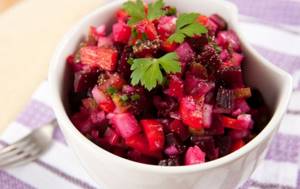
How many kilograms can you lose if you eat only vinaigrette, you ask. It all depends on the duration of the program. The strictest version involves eating only lettuce and water for three days. During this time, 2-4 kg of weight will be lost. It is difficult to maintain such a regime.
If you adhere to a more loyal, but long-term program, you are guaranteed to lose 7-10 kg in 1-2 months. To do this, you need to eat vinaigrette, you can combine the salad with other foods, the main thing is to exclude sweets, flour, fatty and fried foods. The daily calorie intake should not exceed the limit of 1200 kcal. Don't forget to drink a lot, the optimal fluid intake per day is 2 liters.
“Regular vinaigrette”: recipe and calorie content of the dish
To prepare a dish according to a traditional recipe, you will need the following products:
- fresh beets – 300 g;
- fresh potatoes – 100 g;
- fresh carrots – 150 g;
- favorite greens: dill, parsley, etc. – 20 g;
- onion – 50 g;
- peas, canned green – 4 tbsp. l.
- 4 tbsp. l. vegetable oil.
The preparation process is simple: vegetables need to be thoroughly washed and boiled until tender. When the gifts of nature have cooled a little, you can start slicing them. Peel the beets and cut them into cubes.
Peel the carrots and chop them into small squares, remove the skin from the potatoes and cut them in the same way as other vegetables. Combine the prepared products in one bowl, add peas and onions, chopped into thin half rings, mix everything and season with vegetable oil. Before serving, sprinkle the dish with chopped herbs.
The calorie content of such a vinaigrette with vegetable oil will be about 125 kcal per 100 grams. On the one hand, the figure is impressive, but on the other hand, the salad is quite filling and, if you eat it in moderation, there will be no harm to your figure.
Recipe for vinaigrette with sauerkraut without potatoes
It is believed that the two most high-calorie ingredients in this salad are butter and potatoes. Let's try to learn how to make a tasty dish without adding root vegetables. To prepare, you need to take boiled vegetables: beets – 700 g; carrots – 400 g, peeled and cut into cubes. Add 400 g of chopped pickles and half a kilo of sauerkraut to the prepared gifts of nature. Take 100 g of onion, remove the skins from it and finely chop it, add to the other ingredients.
In this recipe, it is recommended to take not canned, but frozen peas - 400 g. Before adding them to the salad, they need to be boiled, cooled, and then mixed with other products. The finished dish is seasoned with 45 g of flaxseed oil and garnished with finely chopped green onions.
The calorie content of such a vinaigrette with butter per 100 grams will be no more than 50 kcal.
Let's learn how to prepare a delicious vinaigrette without oil and peas
If the calorie content of a traditional salad is high for you, then you can make the dish according to a different recipe without adding butter to it.
To prepare, take:
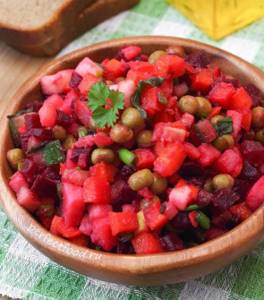
- 180 g beets;
- 150 g carrots;
- 100 g potatoes;
- 100 g pickled cucumbers;
- 200 g sauerkraut.
The cooking process is not too different from the previous recipe: carrots, potatoes and beets need to be boiled, cooled, peeled and cut into equal cubes.
Grind the cucumbers in the same way, mix all the ingredients in one bowl, add the cabbage, no need to squeeze it out, the brine will be an excellent salad dressing, and you can eat it. The calorie content of vinaigrette prepared without oil will be no more than 36 kcal per 100 grams.
The number is very small, so you can enjoy the dish without worrying about your slim figure.
Salad recipe with beans without potatoes
It’s very tasty to add boiled beans to your favorite salad. The energy value of this product is low, so the weight loss process will not be slowed down due to the addition of an unusual ingredient.
To prepare the dish, take:
- 200 g of boiled beets and carrots;
- 150 g pickled cucumbers;
- 150 g boiled beans;
- salt – 2 g;
- olive oil – 15 g.
Boiled vegetables, beets and carrots, need to be peeled and cut into small cubes, similarly chop pickled cucumbers. Add beans to the prepared ingredients. Season the salad with oil, mix and eat. The calorie content of the finished dish will be 68 kcal per 100 g.
Today you learned several interesting and tasty recipes for making vinaigrette.
If you want to experiment with the ingredients in the salad yourself, use a calorie analyzer to calculate the energy value of the finished dish. You can easily find such a program on the Internet or, if you have a modern phone, you can download a convenient device directly to the handset. The analyzer will make life much easier for ladies who are just learning to determine the energy value of ready-made dishes, as well as for those who like to come up with their own recipes.
If you still have little experience, and you don’t know where to look at the exact number of calories in a particular product, remember the simple rules that will help reduce the calorie content of the vinaigrette.
- If you decide to lose weight, but still want to enjoy the salad we are discussing today, do not add potatoes to it. The absence of this ingredient will make the dish less caloric;
- Avoid canned peas; it is better to replace them with frozen ones, which you can boil and cool before adding to the dish;
- Don't dress your salad with oil. Give preference, for example, to cabbage brine. It is also very tasty to season the vinaigrette with kefir, natural yogurt and cottage cheese;
- If you control the amount of salty foods, you don’t have to put cucumbers and cabbage in the salad; replace these ingredients with seaweed. It contains a lot of iodine and is beneficial for the body;
- Add more herbs to the vinaigrette. This is delicious;
- Use salt to a minimum, especially if the composition already contains cucumbers and sauerkraut.
When losing weight, you shouldn’t deny yourself your favorite dishes, you just need to be responsible about cooking recipes and, if possible, remove high-calorie ingredients from your food. Follow these recommendations and you will definitely achieve the figure of your dreams. Good luck!
Vinaigrette is one of the most favorite salads in our country! It becomes especially relevant during the cold season, when fresh produce from the garden is no longer available, but you want to pamper yourself with vegetables. This is a light and pleasant snack that is ideal for both meat and fish dishes, and any side dishes.
The vinaigrette can also easily act as a main meal between meals. So what is the secret of his popularity? Is this salad healthy, and is it dangerous for your figure to eat it in large doses? So, vinaigrette - calorie content, benefits and products that are used to prepare the most popular salad.
There is a well-known story (it must be said, not confirmed in any way) that vinaigrette was invented in Rus' during the time of Peter I. Then it was customary to serve all vegetables, both fresh and boiled, to the table separately, on different plates. But somehow a Russian court chef, instead of traditionally serving boiled vegetables separately, decided to chop them finely and mix them in one bowl.
The king liked it so much that this dish began to appear often on his table and gained wide popularity among the courtiers. Over time, rumors about the king's favorite food spread far beyond the borders of his castle. Due to the availability of all the ingredients of this dish, it has become very popular among the common people. Thus, we got the recipe for the famous salad.
The name of this dish comes from the French word vinaigrette, which means “vinegar dressing.” Thus, a mixture of finely chopped vegetables, seasoned with vinegar, vegetable oil and seasonings, with the light hand of a Frenchman unknown to history, who served as an assistant cook in the royal kitchen, acquired its famous name.
Mono-diet with vinaigrette
If vinaigrette has an average calorie content close to 100 kcal, is it possible to eat it while losing weight? Not only is it possible, but even necessary. After all, the diet itself involves losing 2 kilograms of weight in just 3 days.
The essence of this diet is that all this time you can eat only vinaigrette in almost unlimited quantities. But at the same time, the salad cannot be salted or seasoned with sunflower oil, and it is recommended to use low-fat yogurt as a sauce. For a snack, you can allow yourself some fresh fruit, such as an apple or a pear, and also drink a glass of low-fat kefir.
As evidence of the effectiveness of vinaigrette for weight loss, you can find many positive reviews about this diet on the Internet. But this is not the main thing, but the fact that with such a dish you will not remain hungry even with strict calorie counting.
Do you want to prepare not just a salad, but a real work of art that will outshine even professional chefs in its taste? Then use the following recommendations:
- To ensure that the ingredients in the vinaigrette do not lose their color, you need to mix them with oil separately and only then combine them in a common bowl.
- Do you want the opposite to happen and the vinaigrette to take on a rich burgundy hue? Then add a little beet juice before the sauce and mix it in the salad.
- The taste of vegetables will be much richer if you steam them. In addition, such ingredients retain all their beneficial properties.
- You need to add salt and other spices to the vinaigrette before dressing, otherwise nothing will work.
- It is better to add dressing or vinaigrette sauce in small portions, stirring constantly. It is important that the vegetables are soaked in oil or mayonnaise, and not float in it.
- Do you want to get a truly healthy dish from a nutritional point of view? Then it is better to replace potatoes with beans, and canned green peas with fresh or boiled ones.
The vitamin and mineral composition of the dish is represented by vitamins A, B1, B2, B5, B6, B9, C, E, H, PP, potassium, calcium, magnesium, phosphorus, iron, iodine, cobalt, manganese, copper, molybdenum, fluorine, chromium , zinc.
To understand why the calorie content of vinaigrette with butter and potatoes is so low (as already mentioned, 100 g of product contains only 130 kcal), you should look at the composition of the dish in more detail. The standard vinaigrette recipe (for 4 servings) uses:
- boiled potatoes (100 grams);
- boiled carrots (150 grams);
- onions (50 grams);
- boiled beets (300 grams);
- parsley (20 grams);
- sunflower oil (4 tablespoons).
Except for oil, all components are characterized by a low calorie content.
To prepare the vinaigrette, you need:
- boil carrots, beets and potatoes;
- cut boiled vegetables into cubes;
- add finely chopped onions to vegetables;
- season the mixture with sunflower oil;
- Garnish the dish with parsley before serving.
Vinaigrette recipes: from classic to avant-garde
Of course, every housewife prepares this dish in her own way, each has her own tricks and little secrets.
But the most “correct”, classic recipe for making vinaigrette is considered to be the one that contains the following ingredients:
- Boiled beets, potatoes and carrots
- Green or onions
- Salted cucumbers
- Sauerkraut
- One chopped boiled egg
The recipe itself is very simple. Vegetables and eggs are pre-boiled, then finely chopped and mixed with the rest of the ingredients. Moreover, all components are included in the dish in such proportions that depend only on the taste of the hostess. Except that onions and potatoes, as a rule, are added 100-200 grams less than other vegetables.
The classic dressing is prepared from the following ingredients: a few grams of vinegar, a couple of tablespoons of vegetable oil and spices to taste. All this is mixed and poured into a dish with the main ingredients. Sometimes the vegetables are not mixed, but placed on a plate one by one so that there is a layer of chopped potatoes on top.
As you can see, the recipe is extremely simple, and the calorie content of the vinaigrette with traditional ingredients is very low.
But nowadays, when even the most exotic products have become easily accessible, this salad according to the classic recipe is prepared less and less often. Of course, vinaigrette is never prepared without potatoes, for example. But increasingly, 100 grams of canned green peas are added to the salad. Sometimes finely chopped herring is used instead of pickled cucumbers, and sauerkraut in vinaigrette is used very rarely now.
There are also housewives who like to cook this dish with boiled meat, fish, or add 30-50 grams of mushrooms to the salad. Less common are variations with cheese, beans, fresh cucumbers instead of salted ones, with avocado and even walnuts, prunes and... mango! In general, there are no limits to imagination! Of course, all these products not only change the classic taste, but also significantly increase the calorie content of the vinaigrette.
The recipe for the traditional dressing has also changed radically. Instead of vegetable oil, housewives are increasingly beginning to use mayonnaise, various ready-made ketchups and even honey and yoghurts, without asking the question “How many calories are in the vinaigrette?” and can such mixtures with exotic ingredients and dressings bear the classic name of salad?
The harm of vinaigrette
The harm of vinaigrette is extremely rare and usually consists of the following:
- consumption of sauerkraut salad is contraindicated for ulcers, colitis, gastritis;
- when eating stale vinaigrette, serious stomach and intestinal disorders cannot be ruled out, for example, you may experience diarrhea, flatulence, nausea, vomiting, constipation;
- The amount of vinaigrette consumed is limited in case of diabetes. This is due to the fact that the components in the dish are quickly absorbed, increasing the concentration of insulin in the blood.
Translated from French, “vinaigre” is just vinegar. Later it was invented in which this “spoiled wine” played the main role. An equal amount of olive oil and a small amount of olive oil were added to it. Vegetables sprinkled with this dressing turned out to be as if marinated and at the same time seasoned with oil. The sauce was called "vinaigrette", actually a diminutive name for "vinaigrette". Translated into Russian you can say “vinegar”. Well, we Slavs, as always, misunderstood something and came up with our own dish - vinaigrette. The calorie content per 100 grams of this salad is low, because it consists of boiled or pickled vegetables.
Is vinaigrette dangerous for your figure?
Let's take a closer look at the calorie content of a vinaigrette prepared according to a classic recipe.
Obviously, how many calories are in the vinaigrette depends on the calorie content of all its components. For clarity, we present these data in the table, based on the average amount of ingredients per 1 serving of salad.
As you can see, per 100 grams of salad, the calorie content of the vinaigrette is very small. This is a good dietary dish that will not harm your figure at all if you consume it in moderation in accordance with your physical activity and lifestyle.
But keep in mind that if instead of vegetable oil you use mayonnaise for dressing, and add only a few grams of nuts or meat to the vegetables, then the calorie content of such a dish will increase many times!
Vinaigrette is one of the easiest to prepare, healthy and delicious dishes, which is also quite affordable, since the simplest and cheapest ingredients are used to assemble this salad. We love vinaigrette not only because of its nutritional properties, but also because of its colorful appearance; this salad looks great on both everyday and holiday tables.
Light snack ideal as a side dish
to fish or meat dishes, and also perfectly plays the role of a main course. However, many people ask questions: what is the calorie content of vegetable vinaigrette, is it possible to eat it while losing weight, and what are the benefits of salad for the body? In today's article we will try to answer this and other questions.
Calorie content and BZHU
For people who adhere to the principles of proper nutrition (PN), it is important to know the nutritional and energy value of the foods they eat. This is necessary in order to create a balanced diet, excluding harmful foods from it.
The table below details the calorie content of each ingredient per 100 grams.
KBJU classic vinaigrette recipe.
The most high-calorie ingredient in the salad is sunflower oil. Its energy value should not scare people who are losing weight, since an average of about 10 grams of oil is added to 100 grams of vinaigrette.
Vinaigrette in dietetics
The large amount of vegetables contained in the vinaigrette primarily contributes to the normal functioning of metabolism,
which is very important when losing weight. Due to the fact that they are boiled in their peels, vegetables completely retain all their beneficial properties, microelements and vitamins, such as, phosphorus and.
It should be noted that vinaigrette is also a means of strengthening the immune system.
, while possessing pronounced bactericidal properties.
The undeniable advantage of vinaigrette is its low calorie content.
, which is not increased even by the starch contained in many vegetables.
The salad is perfectly digestible and quickly fills you up: after eating it, you won’t even want to look in the direction of the refrigerator for several hours. There are several excellent vinaigrette-based diets that allow you to lose up to 4 kilograms in 3-4 days.
Classic diet with vinaigrette
The salad prepared for this diet should be seasoned with viscous cottage cheese or yogurt - this way you will reduce the energy value of the dish to a minimum. Eat the vinaigrette three to four times a day, washed down with low-fat kefir or green tea without sugar. The total duration of the diet is from 3 to 6 days, during which time you will lose approximately 3-8 kg.
Diet "Match"
As part of the well-known diet based on the abstinence of meat, salt and sugar, vinaigrette is recommended for dinner in combination with a glass of kefir or fermented baked milk. After just a week, you can lose up to 5 kilograms of net weight, and if you include vinaigrette in your lunch menu, you will lose about 7 kg.
Strict diet
This type of diet is recommended for those who would like to get rid of extra pounds and improve their health. It is designed for 7 days and every day the vinaigrette should be consumed for breakfast along with a glass of skim milk and a piece of rye bread with butter. After such a hearty breakfast, lunch should be postponed to a later time; in between, do not eat anything.
Fasting day
To quickly lose up to 2 kg in just a day, include 100 g of vinaigrette in your dinner menu, adding two boiled eggs and a piece of bread to the salad. You can also drink one cup of herbal tea without granulated sugar.
In addition to losing weight, a vinaigrette diet can improve the condition of your skin and hair, normalize blood pressure and significantly reduce cholesterol levels.
Vinaigrette with canned peas
Green peas are considered healthy because they retain all their qualities in this form. In addition, it has a delicate sweetish taste, which goes well with the salty ingredients of the vinaigrette. Peas contain a lot of vitamins, they are rich - all this is useful for people who follow diets to lose weight. In addition, peas help remove toxins and improve the functioning of the digestive tract.
While following a low-calorie diet, eating peas provides great benefits to the digestive system.
If there is not a lot of oil in such a volume of the dish - no more than five or six tablespoons, then the energy value of the vinaigrette with peas will be 80 kcal per hundred grams.
Vinaigrette: classic recipe
There are a great many different recipes for vinaigrette, but the “same” original recipe that our grandmothers used stands out. This salad is quite nutritious, but its calorie content is quite low, this dish is perfect for a children's breakfast before school.
You will need:
- 6 medium potatoes;
- 3 large beets;
- 3 small carrots;
- 4 pickled cucumbers;
- 300 g sauerkraut;
- 1 can of green peas;
- 1 bunch of green onions;
- 100 ml sunflower oil.
Preparation
Wash the potatoes, carrots and beets thoroughly and place them in a large saucepan. Pour water over the vegetables and cook over medium or low heat until tender. After this, drain the water and allow the components to cool thoroughly. We clean all the vegetables and cut them arbitrarily depending on your taste.
Mix them together, pouring them into a spacious salad bowl. Cut the pickles in half and allow excess liquid to drain. Then cut them into cubes and add to the mixture of potatoes, beets and carrots. Add sauerkraut and green peas there and mix. Finely chop the green onions and add them to the salad, season with oil.
Calorie content
classic vinaigrette with vegetable oil and potatoes per
100 grams is 77 kcal.
Vinaigrette with beans
This nutritious dish will be useful for those who are coming off strict diets, as well as those who want to provide complete healthy nutrition for themselves and their loved ones.
You will need:
- 2 medium potatoes;
- 1 small beet;
- 2 large carrots;
- 1 medium onion;
- 2 pickled cucumbers;
- 100 g canned beans;
- 100 g sauerkraut;
- 50 ml sunflower oil.
Preparation
Boil potatoes, carrots and beets in their skins, after thoroughly rinsing them under running water. Then cut the vegetables into strips and mix together in a large salad bowl. Peel the onion, cut into half rings and add to the rest of the vegetables.
Cut the cucumbers into halves and allow the excess juice to drain. Then finely chop them and place them in a salad bowl, mix the mass thoroughly. Add the cabbage and canned beans last, then season the salad with oil.
Calorie content
vinaigrette with beans is
82 kcal per 100 grams.
Raw vinaigrette

In this case, you need to stock up on the following products:
- one beet;
- two hundred grams of carrots;
- two hundred grams of asparagus;
- two fresh cucumbers;
- one tablespoon of sesame seeds;
- a mixture of the juice of one lemon and a tablespoon of soy sauce.
Pre-peeled beets must be grated on a fine grater, and the carrots must be chopped into long strips (this vegetable is also cut when preparing Korean carrots). The cucumbers are peeled and cut into small cubes. The asparagus is also finely chopped. All vegetables need to be transferred to a deep bowl and a mixture of juice and sauce should be added, then mixed thoroughly. Sesame seeds are added to the resulting mixture, after which the dish is mixed again.
How to cook and eat vinaigrette for weight loss
Vinaigrette, which is a frequent guest on everyday and holiday tables, is a dietary product. Due to its low calorie content, salad can help you lose several kilograms of excess weight.
But vinaigrette for weight loss is somewhat different from the usual version, as it involves the use of slightly different ingredients. To find out how the dietary version of the salad is prepared and why it is so good for your figure, read on to the article.
Is vinaigrette good for weight loss?
Undoubtedly, the dish is one of the most effective for combating excess weight. It not only helps you lose weight, but also activates the gastrointestinal tract. Due to the beets included in the salad, the body is cleansed of toxins, since this vegetable contains a lot of fiber.
Thanks to vegetables, the salad is enriched with various vitamins and other beneficial elements. Calcium, iodine, iron, potassium - all this is contained in the vinaigrette. By eating this salad, you can not only get rid of several kilograms, but also improve your health. Vitamins and minerals help improve the quality of nails, hair and skin, and they also normalize blood pressure.
Nutritionists have no doubt about whether it is possible to eat vinaigrette for weight loss. In fact, the product is also recommended by cardiologists and gastroenterologists.
What are the benefits of vegetables included in vinaigrette?
Salad is good for losing excess weight because it allows you to quickly get enough of a small portion. Therefore, a salad diet is often tolerated without much difficulty. Despite the fact that vinaigrette is a fairly satisfying meal, eating this dish exclusively can be a challenge for some. But for the sake of results, you can tolerate the monotony of the menu a little.
The diet itself should last at least three days, otherwise your efforts may be in vain. But if you hold out for the required period, you can lose up to three kilograms in such a short time. After all, the daily calorie intake when eating salad is approximately 800 - 1000 kcal, which is much less than the norm.
Nevertheless, vinaigrette is also useful because it normalizes the functioning of the gastrointestinal tract. With it there will be no problems with stool, which often plague those losing weight on a low-calorie diet.
Also, the vinaigrette diet can be extended to 5 or 10 days. In this case, even more extra pounds will be lost - from 5 to 8. At the same time, other products must be included in the daily menu: kefir, fresh fruit.
Calorie content of the product
Salad can be called a dietary dish. One hundred grams of the product contains only about 83 kcal. It is worth noting the good ratio of proteins, fats and carbohydrates. The proportions look like this: 1.7, 4.7 and 8.5 grams per serving. It is thanks to these caloric content that vinaigrette is very suitable for weight loss.
Salad also helps the body begin to tap into energy reserves. Thus, a person receives the main part of it not from the dish, but from fat deposits.
Diet recipe
There are several options for preparing vinaigrette for weight loss. But the lighter version is best. It is usually made from vegetables that are not fully cooked. In this form, the products manage to retain the maximum amount of useful components. You need to stock up on salad for the whole day, preparing a larger portion in advance.
https://www.youtube.com/watch?v=mgp6NfCGgA4
The recipe for vinaigrette for weight loss is quite simple. To prepare it you need to purchase the following products:
- potatoes - 2 tubers;
- carrots - three pieces;
- two medium-sized beets;
- a couple of pickles;
- onions – 1 piece;
- canned peas - one can;
- sauerkraut – 200 grams.
Boil carrots, potatoes, beets until half cooked. Afterwards they must be removed from the heat. Cut vegetables and pickles into cubes and place in a bowl. Add peas and cabbage to them, mix everything thoroughly. It is recommended to season dietary vinaigrette exclusively with oil. Sunflower or olive oil work well. You can add chopped fresh herbs.
Gourmets can further modernize the dietary vinaigrette by seasoning it with mustard sauce. Boiled beans can also be an additional ingredient for the salad.
The diet involves eating the dish for three days, and only it. Drinks include only water or green tea without sugar. Also, in some cases, it is allowed to diversify the diet with fresh fruits.
Is it possible to cook without potatoes?
Vinaigrette can rightfully be considered a dietary dish. But in order to increase its effectiveness for weight loss, some of its components should be eliminated or replaced. First of all, this applies to potatoes. The root vegetable contains a lot of starch, which will only add extra pounds. Therefore, you can make a vinaigrette without potatoes.
But if your love for the product is too great, you can simply reduce the amount in the salad.
The composition of the ingredients in the dish without potatoes is somewhat different from the usual dietary version. It is prepared from the following products:
- fresh cabbage – 250 grams;
- beets - one medium root vegetable;
- 200 grams of carrots;
- a couple of fresh cucumbers;
- one lemon;
- fresh greens.
It is necessary to finely chop the cabbage. Wash beets, carrots, cucumbers thoroughly and cut into small cubes or slices. Next you should do the same with the greens. When all the ingredients are chopped, they need to be combined in some container, add salt and pepper to taste.
For a vinaigrette without potatoes, there are two dressing options. The first is a sauce made from mustard, vinegar and olive oil. It also contains few calories, that is, it does not “weight” the salad. The second option is soy sauce with lemon juice. Both types of dressing will perfectly reveal the taste of the vinaigrette and will not add extra calories to it.
Is vinaigrette suitable for dinner?
You can safely eat salad in the evening. After all, the vinaigrette contains healthy vegetables, the consumption of which will definitely not lead to the addition of extra centimeters at the waist. Only potatoes can have a negative effect, but, as a rule, in the dietary version of the salad its quantity is halved.
The only thing you need to remember: you can eat vinaigrette for dinner, but you shouldn’t eat it right before bed. At least three hours should pass since your last meal before going to bed.
We recommend reading about the salad Brush for weight loss. From the article you will learn about how the Brush salad for weight loss works, recipes, and the results of cleansing the intestines.
And here is more information about the benefits of beets for weight loss.
Vinaigrette is great for helping you get rid of a few extra pounds in just a few days. Thanks to the composition rich in vitamins and minerals, the salad not only allows you to lose weight, but also helps cleanse the intestines.
Watch this video about the principles of making vinaigrette:
Source: https://HudeiSkorei.com/vinegret-dlya-pohudeniya/
Dietary vinaigrette: low-calorie recipes, options without potatoes for weight loss
Vinaigrette is a widely loved dish. But few people know that this is not only a tasty, but also a healthy salad. Especially for those who want to make their figure attractive and maintain physical fitness. It is also recommended for adherents of proper nutrition (PN).
The composition of the dish allows us to consider the vinaigrette a dietary dish. However, you should not limit yourself to just one recipe. It is recommended to regularly prepare vegetable salad with a new composition. The most common recipes are given in the article.
Is salad suitable for weight loss, dieting and PP?
Preparing a vinaigrette is extremely simple, and the ingredients for it can be found at any time of the year. But they are the ones that determine the calorie content, benefits and taste of the salad. You can use vinaigrette both as part of a diet and as a component of your usual diet - the dish is still a dietary one.
The basis of the vinaigrette is vegetables, which makes the composition of the dish optimal not only for weight loss, but also for maintaining an active lifestyle in general.
The salad contains a significant amount of vitamins B, A, PP, C and E (the latter has antioxidant properties - it prevents the formation of peroxides that damage cells and cause their premature death).
The salad also contains a whole range of essential minerals. The vinaigrette is rich:
- iron;
- zinc;
- magnesium;
- potassium;
- phosphorus;
- copper, etc.
A successful combination of products in a vinaigrette can improve the functioning of the digestive tract and nourish hair, nails, and skin. Also, its regular use will reduce cholesterol and blood pressure.
Considering that most salad recipes contain potatoes (a fairly high-calorie product), the question arises regarding the calorie content in the vinaigrette. Despite this ingredient, vinaigrette is a dietary salad. A standard serving (150 g) contains about 90 kilocalories (kcal). And if you prepare a dish without potatoes, you can make an extremely low-calorie vinaigrette.
Attention! To digest vinaigrette, the body spends significantly more energy than it receives from food. Therefore, it uses alternative energy sources - it breaks down fat deposits.
How much can you save by eating vinaigrette?
By sticking to a diet consisting of vinaigrette, you can get rid of extra pounds without significant effort. This is due to the fact that the salad is not only light and healthy, but also satisfying. However, the severity of the effect depends on the duration and severity of the diet.
The toughest option allows you to lose from 2 to 4 kg of excess weight. However, such weight loss requires eating only the most dietary vinaigrette and water for 3-4 days.
Such a diet is not only difficult to maintain, but it can be harmful to health.
A more loyal, but also long-term, diet allows you to lose up to 10 kg within 1.5-2 months. To achieve such results, the diet must include other foods, otherwise the harm done to the body will exceed the benefits. The key condition for dietary nutrition is the exclusion of consumption of sweets, flour, fried and fatty foods. It is extremely important to drink at least 1.5-2 liters of liquid per day.
In the dietary diet, daily caloric intake should not exceed 1200 kcal.
Ingredient options: seasonal vegetables, original products
Traditionally, vinaigrette is made from seasonal vegetables. The classic recipe uses:
- beets;
- cucumbers (salted, less often fresh);
- carrot;
- potato;
- greenery;
- peas;
- onion;
- sunflower or olive oil;
- salt.
The recipe can be modified depending on individual taste preferences and product availability. Cabbage (both fresh and pickled), lemon, corn, beans, and lettuce look harmonious in a vinaigrette. The following ingredients will help diversify the taste and decorate the menu:
- parsnip;
- plain yogurt;
- Dijon mustard;
- nuts;
- eggs;
- lean meat;
- sour cream;
- squid;
- pomegranate.
Interesting! Vinaigrette is one of the salads in the preparation of which culinary experiments are encouraged.
Step-by-step preparation of a classic vinaigrette
Although this vinaigrette is classic and its recipe remains unchanged, you can prepare a dietary salad in 2 ways.
Ingredients (for 4 servings):
- boiled potatoes – 5 pcs.;
- boiled beets – 2 pcs.;
- boiled carrots – 5 pcs.;
- pickled cucumbers – 4 pcs.;
- 1 onion;
- black pepper, salt - individually.
How to prepare a dietary dish depends only on individual preferences. In any case, potatoes, beets and carrots need to be boiled. They and cucumbers should be cut into cubes, and the onions should be cut into half rings.
Preparation:
- Option. Vegetables (excluding beets) need to be chopped, mixed and seasoned with oil (sunflower, less often olive). The beets are cut and seasoned separately; they should stand for about 5-7 minutes. Only then can the salad components be mixed. This cooking method allows you to highlight the taste of individual vegetables.
- Option. All components are cut, mixed, and only then is it time to season. If you prepare the vinaigrette in this way, it will have a uniform structure and deep red color.
Low calorie recipes
Depending on what ingredients will be included in the vinaigrette, you can adjust the calorie content of the dietary dish. Below are the most common options. This does not mean that you need to cook only according to them; you can choose other recipes or prepare a vinaigrette according to your preferences. The main thing is the low calorie content of the salad.
Summer
This delicious salad is truly dietary. Calorie content per 100 grams is only 90 kcal. To prepare the vinaigrette, you will need (calculated for 200 gram portions):
- 2 medium potatoes;
- 2 carrots;
- medium-sized beets - 1 piece;
- 70 g fresh cabbage;
- 2 medium fresh cucumbers;
- tomatoes – 2 pcs.;
- fresh apples – 2 pcs.;
- a medium bunch of onions and the same number of green salad leaves;
- a bunch of dill and parsley;
- 3 tablespoons canned peas;
- 110 g butter;
- 1 tsp. salt.
How to cook. Potatoes, beets and carrots are boiled and cooled separately. They and cucumbers are peeled and cut. Tomatoes are cut into thin slices. Shred lettuce leaves. Mix everything, add salt and add oil. Then everyone gets in the way. The dietary vinaigrette is ready.
No potatoes
Preparing a vinaigrette without potatoes makes an already dietary dish practically calorie-free. There are only 43.8 kcal per 100 g of finished dish. At the same time, the vinaigrette contains proteins, fats and carbohydrates (BJU) in an amount of 1.7/1.2/6.9 g.
To prepare you need:
- 200 g peas (can be frozen or canned);
- the same amount of celery;
- 1 boiled beets;
- 2 carrots;
- 180-220 g sauerkraut;
- 1 tbsp. l. oil (preferably olive);
- 1-2 tbsp. l. lemon juice.
How to prepare:
- If you use canned peas, they are added like this; if they are frozen, they need to be boiled. You need to finely chop the celery and grate the carrots. The beets are cut into cubes.
- The cabbage is washed to remove excess salts.
- Mix the ingredients and season with oil, after which you need to mix them again and add lemon juice.
- Stir the prepared most dietary vinaigrette again.
"Raw"
The name of the dietary dish is due to the presence of raw beets in it. The remaining vegetables are cooked, as with the classic recipe. At the same time, the calorie content is only 47 kcal per 100 g.
Required in grams:
- canned green peas – 250 g;
- sauerkraut – 50 g;
- boiled potatoes – 220 g;
- onions – 70 g;
- cucumbers and carrots - the same amount;
- beets – 230 g.
Preparation. Coarsely grate the beets and sprinkle with lemon juice. Boiled carrots and potatoes, cut cucumbers into small cubes. Finely chop the onion. Mix the ingredients.
Mushroom
An unusual recipe that allows you to colorize your diet. Calorie content for 4 servings – 217 kcal. To prepare the dish, you need to take:
- beets – 1 medium;
- potatoes 2-3 medium root vegetables;
- carrots – 2 pcs.;
- pickled mushrooms – 220 g;
- pickled cucumbers – 1 medium size;
- onion – 1 pc.;
- individually salt and ground black pepper;
- sunflower oil – 2 tbsp. l.;
- lemon – 1 pc.
Boil vegetables and cut into cubes. Cucumbers, onions and mushrooms are chopped. Mix the ingredients and squeeze lemon into them. Add seasonings.
With beans
This dietary salad contains 81.6 kcal per 100 g. The ingredients you will need (calculated for 5 servings):
- 2 potatoes;
- beets – 1 pc.;
- 2 carrots;
- 1 medium onion;
- 2 cucumbers (salted or lightly salted);
- 110 g cabbage (sauerkraut or fresh);
- 350 g beans;
- vegetable oil – 20-30 g;
- salt - individually.
Preparing a dietary dish is simple: boil the vegetables and chop them. The cabbage is washed and the ingredients are mixed and spices are added. Mix everything again. At the end, add canned beans, after draining the liquid.
Main conclusions
- Vinaigrette is a dietary salad.
- The dish allows you to quickly get enough.
- Digesting vinaigrette requires more calories than are contained in the food itself.
- The recipe without potatoes is the lowest in calories.
Vinaigrette is a prime example of a dietary dish. It is recommended to be consumed by both those who want to lose excess weight and those who like to lead a healthy lifestyle and eat right, thanks to the high content of vitamins and minerals in the salad.
However, sticking to a diet of vinaigrette alone should not last more than 4-5 days.
Source: https://gercules.fit/diety/blyuda-i-napitki/dieticheskij-vinegret.html
How many calories are in vegetable vinaigrette?
The calorie content of vegetable vinaigrette depends on the chosen recipe, the set of products used, and the method of preparation. On average, 100 g of ready-made snack contains 130 Kcal, thanks to which the dish can be safely included in the diet menu. Vegetables rich in fiber quickly saturate the body, satisfying hunger for a long time and preventing extra pounds from being put on.
To preserve the beneficial properties of the ingredients, nutritionists advise:
- do not boil vegetables, but steam them;
- use fresh or frozen beans and peas instead of canned ones.
With potatoes and butter
Vinaigrette with potatoes and butter is traditionally seasoned with vinegar-sunflower sauce. The calorie content of such a snack is 150 Kcal per 100g. However, the dish can be varied with various oils, each of which has its own benefits:
- corn - participates in the breakdown of fats;
- olive – has pronounced anti-inflammatory properties;
- mustard – helps preserve the freshness of the prepared dish;
- flaxseed is a low-calorie substance that saturates the body with fatty amino acids;
- sesame – rich in calcium;
- pumpkin is an excellent source of zinc;
- soy - practically tasteless and odorless;
- nuts - helps the liver deal with toxins.
Thanks to the variety of vegetable oils, the usual cold snack with potatoes will acquire new flavor nuances. A dish prepared taking into account the recommendations of nutritionists will not only become less caloric, but will also allow you to get the maximum benefit. The products will retain vitamins, microelements, natural color, shape, and fresh aroma. Vegetable oils will make the vinaigrette nutritious.
No potatoes
Some dietary recipes for vinaigrettes suggest excluding potatoes from the composition. Green peas or beans are used as an alternative. To increase the benefits of the snack, the recipe is supplemented with frozen or fresh legumes, and flaxseed oil is used as a dressing. The calorie content of such a salad is only 49 Kcal per 100 g, which allows its inclusion in a healthy diet.
With peas
Green peas are a tasty, healthy product containing easily digestible protein, vitamins and microelements. It has a mild diuretic effect and has a beneficial effect on the functioning of the liver and kidneys. Pea vinaigrette is made from fresh, frozen or canned legumes, which add extra freshness to the dish. 100 g of this salad contains 128 Kcal.
With sauerkraut
In some cold appetizer recipes, sauerkraut is used instead of pickles, which gives the dish a refined and piquant taste. If this product is prepared according to all the rules of fermentation without the use of vinegar, it is healthy and can be included in the diet, as it is rich in vitamins and microelements. 100 g of vinaigrette with sauerkraut contains about 104 kcal.
With added beans
Beans, rich in protein, are often used as an ingredient in vinaigrette. The variety of legume varieties provides every gourmet with the opportunity to choose a product to suit their taste. Regardless of the type of bean, it is equally beneficial for the body. Legumes can be added to a salad as an addition to the main ingredients, or as an alternative to potatoes. The calorie content of a cold snack with legumes is about 53 Kcal per 100 g.
With herring
In Scandinavian cuisine, where vinaigrette originates, the salad is prepared with Norwegian herring. Spicy cold-salted fish, combined with vegetables, gives the dish an appetizing and sophisticated note. Experienced chefs recommend soaking the herring in milk, which will remove excess salt and give it special tenderness. Vinaigrette with salted fish contains 119 Kcal per 100 g of finished salad.
Ingredients of the vinaigrette
The dish contains the following ingredients:
- cucumbers;
- potato;
- vegetable oil;
- carrot;
- peas;
- beet;
- salt.
Thanks to such components in the recipe, the vegetable salad contains a large amount of ascorbic and nicotinic acid, B vitamins, and lipophilic components (vitamin K).
Beneficial substances also include:
- beta-carotene;
- cellulose;
- organic acids.
Vinaigrette has a rich chemical composition consisting of the following minerals:
- gland;
- phosphorus;
- magnesium;
- iodine;
- calcium;
- potassium
Dietary vinaigrette
Dietary vinaigrette is considered one of the most popular dishes available in Russia, but this does not mean that the salad is not reputable to serve in restaurants. The dietary version differs from the classic recipe in the absence of high-calorie ingredients and fatty dressings.
Vinaigrette is known to many from Soviet times, but the history of its origin goes back to the times of pre-revolutionary Russia, and Scandinavia is considered the birthplace of the recipe.
Traditionally, the salad is seasoned with aromatic sunflower oil. But a mixture of pickles and oil in a vinaigrette shortens the shelf life of the dish. It is recommended to leave it in the refrigerator for no more than 24 hours. We advise you not to dress the entire salad at once, but only in portions when serving. Store the remaining mixture of ingredients in the refrigerator without oil or sauce.
Step-by-step recipe for Vinaigrette with photos
Dietary vinaigrette - a classic of the culinary genre
Russian classic vinaigrette is considered a vegetable salad. All ingredients are mixed in approximately equal volumes, with the exception of onions, the amount of which in the dish varies depending on the taste.
Ingredients:
- Beetroot (large) – 1 pc.
- Beans – 1 cup
- Carrots (medium size) – 4 pcs.
- Pickled cucumbers – 2-3 pcs.
- Onion – 1 pc.
- Potatoes (medium size) – 3 pcs.
- Sunflower oil.
Preparation:
Boil the root vegetables. Cut all the cooked vegetables into medium cubes, chop the pickled cucumbers and onions too, mix and add the pre-boiled beans to the vegetables. Season with sunflower oil. Add some salt. Oil and salt to taste.
If you want to get a uniform red salad, then mix all the ingredients with the beets at once and season with oil. If you want to preserve the color and taste of each product, mix the beets with oil separately and add to the salad at the end.
This vinaigrette recipe will definitely not harm your figure, because potatoes are excluded from it, and peas replace high-calorie beans.
Ingredients:
- Beetroot (large) – 1 pc.
- Canned peas – 1 can
- Vegetable oil
- Onion – 1 pc.
- Carrots (medium size) – 4 pcs.
- Pickled cucumbers – 2-3 pcs.
Preparation:
Wash and boil the beets and carrots, cut into medium-sized cubes. Add cucumbers and onions chopped in the same way. Top with canned peas. Season and add salt.
It is better to choose aromatic, unrefined oil for dressing. In order to get a juicy salad, but reduce the calorie content of the dish, use water to prepare the dressing. Water and oil in a 50/50 ratio.
Dietary vinaigrette with pickled mushrooms
Mushrooms are the main characters of the salad in this vinaigrette variation. They are considered a dietary vegetable; its composition is 90% water.
Ingredients:
- Beetroot (large) – 2 pcs.
- Pickled cucumber – 3 pcs.
- Carrots (medium size) – 1 pc.
- Marinated mushrooms 150 gr.
- Potatoes (medium size) – 2 pcs.
- Green peas – 1 can
- Green onions - a small bunch
- Olive oil – 3 tbsp.
- Lemon juice – 1 tbsp.
- Mustard – 1 tbsp.
Preparation:
Pre-boiled root vegetables are cut into medium cubes, add diced pickled mushrooms, cucumber, and onion. Add peas. Mix oil, juice and mustard for dressing, add to salad.
Boiled beets, potatoes and carrots contain a lot of calories. One of these ingredients can be replaced with a fresh tomato, which goes well with other products and will not harm your figure. It is not advisable to exclude beets from the vinaigrette, because they provide the main color and taste. In our recipe we replaced potatoes and carrots with tomatoes.
Ingredients:
- Beetroot (large) – 1 pc.
- Tomato (large) – 4 pcs.
- Onion – 1 pc.
- Beans – 1 cup
- Sunflower oil.
Preparation:
Season diced beets with sunflower oil. Boil the beans and add to the beets. Also cut the onion and tomato into cubes, mix all the ingredients and season with oil. Salt to taste.
This salad recipe has a fresh vegetable and will be paired with fresh herbs. For example, parsley or basil. Any one you like is perfect.
Dietary vinaigrette with baked zucchini
This recipe is original in that the zucchini, beets and carrots are baked rather than boiled. Baked vegetables are considered dietary and beneficial for the body.
Ingredients:
- Beetroot (large) – 1 pc.
- Beans – 1 cup
- Carrots (medium size) – 4 pcs.
- Pickled cucumbers – 2-3 pcs.
- Onion – 1 pc.
- Zucchini (large) – 1 pc.
- Sunflower oil.
Preparation:
Cut the zucchini into medium cubes and place on a baking sheet greased with vegetable oil. Grate the beets and carrots on a coarse grater and sprinkle on top of the zucchini. Place in a preheated oven for 20 minutes/180 degrees. Let the vegetables cool, add pickles and diced onions. Mix with boiled beans, season with oil, add salt.
Diet vinaigrette with green apple
Add a green apple to the salad instead of boiled potatoes and carrots.
Ingredients:
- Beetroot (large) – 1 pc.
- Green apple (large) – 2 pcs.
- Fresh cucumbers (medium size) – 2 pcs.
- Onion (red) – 1 pc.
- Carrots (large) – 1 pc.
- Gherkins – 3-4 pcs.
- Vegetable oil.
Preparation:
Cut the boiled root vegetables into medium cubes, add the apple, cucumbers and onions, chopped in the same way. Mix with gherkins and season with oil and salt.
Lettuce leaves are added to the salad instead of pickled cucumber. And the main originality of this version of vinaigrette is in the dressing. For it, they do not use high-calorie oil, but a mixture of mustard, water and honey.
Ingredients:
- Beetroot (large) – 1 pc.
- Potatoes (medium size) – 4 pcs.
- Carrots (medium size) – 4 pcs.
- Lettuce leaves 1 bunch
- Onion – 1 pc.
- Beans – 1 cup
- Mustard, honey, water, salt, pepper.
Preparation:
Cut the boiled root vegetables and onions into cubes, mix with boiled beans and chopped lettuce. For the sauce, mix water, honey, mustard in a one-to-one ratio, salt and pepper to taste.
The editors recommend:
Commenting system SigComments
Source: https://www.salatyday.ru/recepty/recept/1342
Vinaigrette without potatoes and beans. Cooking features
Vinaigrette without potatoes can be prepared according to the same recipes as a regular one, simply excluding the named ingredient from the composition. An even better idea would be to find an appetizer recipe that makes an adequate substitute for potatoes. An alternative can be legumes, Jerusalem artichoke, zucchini and other vegetables. Regardless of which vinaigrette recipe is chosen, the cook will need to know several subtleties of preparing this popular dish.
- If you want to make your diet as healthy as possible, it is better for you to bake vegetables for salad. If you first chop them and only then put them in the oven, they will cook faster, but will be less juicy, and the taste of the vinaigrette will change slightly.
- If you want the vinaigrette to look as bright and colorful as possible, season the beets and other ingredients separately. The oil will cover them with a thin film and prevent staining.
- You can season the vinaigrette not only with oil, but also with a spicy sauce prepared on its basis, with the addition of vinegar, lemon juice, and mustard. If you are preparing a vinaigrette without potatoes just because you didn’t find any in your kitchen, and the calorie content of the food does not matter to you, then you can season the salad with mayonnaise. The appetizer will acquire an interesting taste if you use sour cream instead of sauce.
- Try to cut the vegetables into cubes of the same size, then the salad will look more appetizing.
The vinaigrette without potatoes turns out to be quite satisfying. Like the classic appetizer, it can be served separately or as a side dish. Its taste harmonizes well with both fish and meat dishes. Our compatriots love to combine it with herring.
Vinaigrette with beans. Cooking step by step:
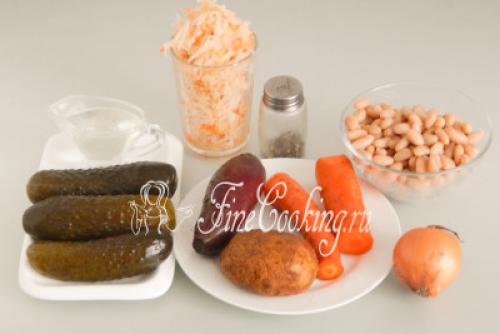
To prepare this delicious vegetable salad, we will need the following ingredients: beets, potatoes, carrots, pickles, sauerkraut, canned beans, onions, vegetable oil and a little ground black pepper (if you like). In addition, before serving, you can add some chopped herbs to the vinaigrette - for example, green onions, dill or parsley.
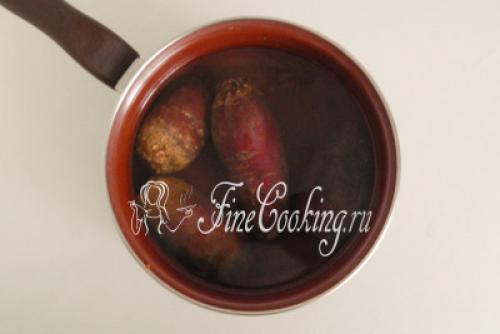
Vegetables for the vinaigrette need to be washed and boiled in their skins. I advise you to cook beets (4 medium-sized pieces) separately from other vegetables, since the cooking time varies, and they can easily color. After boiling, the beets will be ready in 40-70 minutes - it all depends on the size and maturity of the fruit. It’s easy to check for doneness: if the root vegetables can be easily pierced with a knife, drain the water and let them cool.
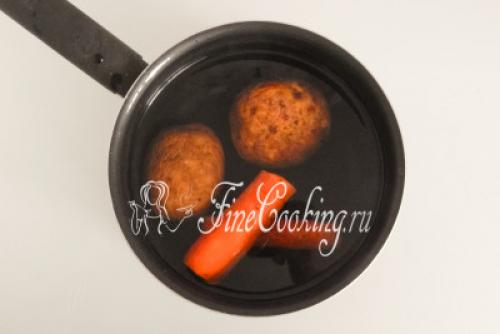
We also cook a couple of potatoes and medium-sized carrots in their skins: 20-25 minutes after boiling is enough. Drain the water and cool the vegetables.
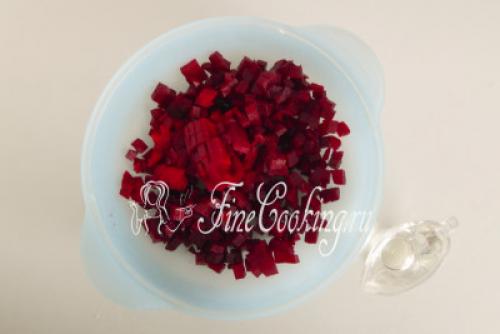
Transfer to a large bowl, season with vegetable oil (4 tablespoons) and mix thoroughly. Thanks to this technique, the remaining ingredients of the salad will not be colored in the future, because the beetroot cubes are covered with an oil film.

Add 200 grams of canned beans and sauerkraut. Season the salad with ground black pepper.
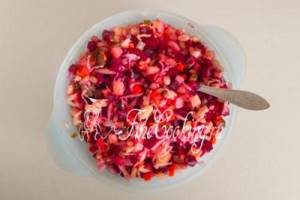
Stir and add more salt if necessary. If you like a more piquant and rich taste, you can add 1 tablespoon of 6-9% vinegar. If you plan to store the vinaigrette with beans for some time in the refrigerator, I advise you not to add the onions right away, but add them immediately before serving (onions cause the vegetables to sour quickly).

This delicious vinaigrette with beans is a salad for any table, but it’s especially good during Lent! Cook for your health, friends, and bon appetit!
Vinaigrette calorie content per 100 grams without oil
Nutritional value and chemical composition of “vinaigrette without oil.”
The table shows the nutritional content (calories, proteins, fats, carbohydrates, vitamins and minerals) per 100 grams of edible portion.
| Nutrient | Quantity | Norm** | % of the norm in 100 g | % of the norm in 100 kcal | 100% normal |
| Calorie content | 44.5 kcal | 1684 kcal | 2.6% | 5.8% | 3784 g |
| Squirrels | 1.909 g | 76 g | 2.5% | 5.6% | 3981 g |
| Fats | 0.164 g | 60 g | 0.3% | 0.7% | 36585 g |
| Carbohydrates | 9.282 g | 211 g | 4.4% | 9.9% | 2273 g |
| Organic acids | 0.145 g | ||||
| Alimentary fiber | 2.327 g | 20 g | 11.6% | 26.1% | 859 g |
| Water | 87 g | 2400 g | 3.6% | 8.1% | 2759 g |
| Vitamins | |||||
| Vitamin A, RE | 311.5 mcg | 900 mcg | 34.6% | 77.8% | 289 g |
| beta carotene | 3.392 mg | 5 mg | 67.8% | 152.4% | 147 g |
| Vitamin B1, thiamine | 0.052 mg | 1.5 mg | 3.5% | 7.9% | 2885 g |
| Vitamin B2, riboflavin | 0.039 mg | 1.8 mg | 2.2% | 4.9% | 4615 g |
| Vitamin B4, choline | 8.15 mg | 500 mg | 1.6% | 3.6% | 6135 g |
| Vitamin B5, pantothenic | 0.2 mg | 5 mg | 4% | 9% | 2500 g |
| Vitamin B6, pyridoxine | 0.091 mg | 2 mg | 4.6% | 10.3% | 2198 g |
| Vitamin B9, folates | 24.273 mcg | 400 mcg | 6.1% | 13.7% | 1648 g |
| Vitamin C, ascorbic acid | 6.33 mg | 90 mg | 7% | 15.7% | 1422 g |
| Vitamin E, alpha tocopherol, TE | 0.387 mg | 15 mg | 2.6% | 5.8% | 3876 g |
| Vitamin H, biotin | 0.082 mcg | 50 mcg | 0.2% | 0.4% | 60976 g |
| Vitamin K, phylloquinone | 5.9 mcg | 120 mcg | 4.9% | 11% | 2034 |
| Vitamin RR, NE | 0.5583 mg | 20 mg | 2.8% | 6.3% | 3582 g |
| Macronutrients | |||||
| Potassium, K | 174.09 mg | 2500 mg | 7% | 15.7% | 1436 g |
| Calcium, Ca | 23.91 mg | 1000 mg | 2.4% | 5.4% | 4182 g |
| Magnesium, Mg | 13.64 mg | 400 mg | 3.4% | 7.6% | 2933 g |
| Sodium, Na | 31.45 mg | 1300 mg | 2.4% | 5.4% | 4134 g |
| Sera, S | 5.91 mg | 1000 mg | 0.6% | 1.3% | 16920 g |
| Phosphorus, Ph | 36.7 mg | 800 mg | 4.6% | 10.3% | 2180 g |
| Chlorine, Cl | 2.27 mg | 2300 mg | 0.1% | 0.2% | 101322 g |
| Microelements | |||||
| Bor, B | 18.2 mcg | ||||
| Iron, Fe | 0.813 mg | 18 mg | 4.5% | 10.1% | 2214 g |
| Yod, I | 0.82 mcg | 150 mcg | 0.5% | 1.1% | 18293 g |
| Cobalt, Co | 0.455 mcg | 10 mcg | 4.6% | 10.3% | 2198 g |
| Manganese, Mn | 0.2047 mg | 2 mg | 10.2% | 22.9% | 977 g |
| Copper, Cu | 61 mcg | 1000 mcg | 6.1% | 13.7% | 1639 g |
| Selenium, Se | 0.527 mcg | 55 mcg | 1% | 2.2% | 10436 g |
| Fluorine, F | 11.45 mcg | 4000 mcg | 0.3% | 0.7% | 34934 g |
| Chromium, Cr | 0.18 mcg | 50 mcg | 0.4% | 0.9% | 27778 g |
| Zinc, Zn | 0.3409 mg | 12 mg | 2.8% | 6.3% | 3520 g |
And a little about secrets.
The story of one of our readers Alina R.:
I was especially depressed about my weight. I gained a lot, after pregnancy I weighed as much as 3 sumo wrestlers together, namely 92 kg with a height of 165. I thought the belly would go away after giving birth, but no, on the contrary, I began to gain weight. How to cope with hormonal changes and obesity? But nothing disfigures or makes a person look younger than his figure. At the age of 20, I first learned that plump girls are called “WOMAN”, and that “they don’t make clothes that size.” Then at the age of 29, divorce from my husband and depression.
But what can you do to lose weight? Laser liposuction surgery? I found out - no less than 5 thousand dollars. Hardware procedures - LPG massage, cavitation, RF lifting, myostimulation? A little more affordable - the course costs from 80 thousand rubles with a nutritionist consultant. You can, of course, try to run on a treadmill until you go crazy.
And when will you find time for all this? And it's still very expensive. Especially now. Therefore, I chose a different method for myself.
How many calories are in vinaigrette?
The average calorie content of a vinaigrette made according to the classic recipe with vegetable oil and potatoes is 110 kcal per 100 g of salad. Therefore, it can be included in the menu when losing weight. In addition, the salad consists exclusively of vegetables, which will have a beneficial effect on the development of the body.
The table shows the calorie content of vinaigrette salad prepared according to the classic recipe with the addition of additional products. This data will help you better understand which product is the safest for your figure.
Calorie table for vinaigrette (per 100 g)
After reviewing the data in the table, we can conclude that the vinaigrette with potatoes, but without vegetable oil, has the lowest calorie content. At the same time, the number of calories increases when herring is added to the salad.
Nutritional value table for vinaigrette salad (per 100 g)
The calorie content of vinaigrette can reach 150 kcal per 100 grams of product
But, be that as it may, knowing how high-calorie vinaigrette is, and even just this dish, certainly won’t hurt you, and will even help you correctly adjust your diet, and make the correct calculation of individual portions of this tasty and, moreover, very healthy salad.
What is the calorie content of vinaigrette prepared in different ways? And here it is:
Calorie table for vinaigrette, per 100 grams of product:
| Product | Calories, in kcal |
| with green peas | 75,6 |
| beans | 67,9 |
| herring | 119,0 |
| mayonnaise and egg | 108,6 |
| mushrooms | 39,2 |
| sauerkraut | 49,5 |
| no potatoes | 48,6 |
| no oil | 35,8 |
And the nutritional value of vinaigrette prepared in different ways is as follows:
Table of nutritional value of vinaigrette (BJU), per 100 grams of product:
| Product | Squirrels, gr. | Fats, gr. | Carbohydrates, gr. |
| with green peas | 1,84 | 3,0 | 10,3 |
| beans | 2,5 | 2,7 | 8,9 |
| herring | 4,5 | 6,8 | 10,5 |
| egg | 4,7 | 6,5 | 7,7 |
| mushrooms | 2,0 | 0,2 | 7,8 |
| cabbage | 2,11 | 0,2 | 10,6 |
| no potatoes | 2,1 | 1,8 | 7,5 |
| no oil | 1,5 | 0,2 | 7,5 |
How is this dish prepared? Yes, very simple! Here's the recipe for you:
Classic vinaigrette
- Beetroot -400 grams
- Carrots -300 grams
- Potatoes -400 grams
- Cabbage (naturally sauerkraut) -200 grams
- Cucumbers (salted or pickled) -200 grams
- Onion -150 grams
- Peas (frozen or canned) -200 grams.
- Salt and pepper - to taste.
- In the same way, to taste, vegetable oil
The beets (without peeling) are boiled until tender (or baked in the oven). Also, without peeling, cook potatoes and carrots separately until tender. Boil the peas - if they are frozen. Then the vegetables are cooled.
Cut the onion finely. Cucumbers - cubes. Finely chop the cabbage.
Beets, carrots and potatoes are peeled and then cut into small cubes.
Mix all the products, add salt and pepper to taste, season with vegetable oil. Before serving, the salad can be decorated with herbs and eaten for health. Moreover, the relatively low calorie content of the vinaigrette will not spoil your figure.
Vinaigrette, calorie content, benefits and dietary properties
Who is not familiar with such a vegetable dish as vinaigrette?
The calorie content of this dish is of interest to many readers. No wonder. After all, the menu of modern people is very different from the natural and healthy food that they ate thousands of years ago. Therefore, today, we often pay for this with various gastrointestinal ailments or excess body weight. How is vinaigrette useful, and what calorie content does vinaigrette have? These questions are especially relevant for those people who try to follow certain diets. So, for example, among the diets popular today is one such as a calorie counter, which is designed to control the flow of excess calories into our body. But at the same time, you need to remember about the benefits of the products. You should know not only what the calorie content of the product is, but also what nutrients it contains.
Vinaigrette without potatoes. Delicious vinaigrette salad without potatoes

In most cases, many of us prepare vinaigrette in the cold season, probably because in the summer we want fresh and bright vegetables. What can I say, I myself have only prepared this delicious salad in winter. Now it’s the beginning of autumn, and believe it or not, I really wanted some kind of winter salad, but definitely light and without mayonnaise. I suggest treating yourself and your household to a vinaigrette without potatoes. If you prepare all the vegetables in advance, you can prepare the salad in minutes.
Ingredients:
- Cooking time: 60 minutes
Number of servings: 4

Vinaigrette salad, recipe with photo, very tasty, without potatoes
First of all, this can be done a day in advance, wash the beets and carrots. Place in a saucepan of cold water and simmer until tender, 30-50 minutes, depending on the size of the vegetables. In principle, you can go to the market and buy the vegetables you need, already boiled. Cool to room temperature.
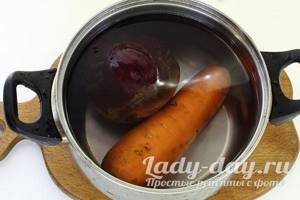
Prepare the vinaigrette dressing. In a plate, mix lemon juice, mustard and odorless vegetable oil. It is convenient to take a small jar, cover with a lid and shake well.
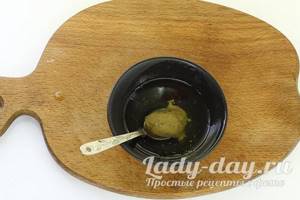
Once the vegetables have cooled, you can start preparing the salad. Remove the skin from the beets. Cut it into small cubes.
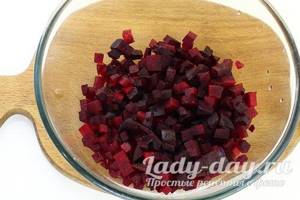
Peel the carrots and cut into the same cubes. Add to beets.

Dip pickled cucumbers in brine. Trim the ponytails on both sides. Cut into small pieces. Add to vegetables.

Wash and dry the parsley. Tear off the leaves and chop finely. Add to salad bowl. Peel the purple onion, rinse and dry. Cut into small cubes. Add to vegetables.
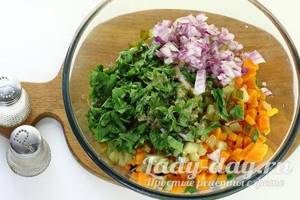
Add ground black pepper and salt to taste. Pour in mustard dressing. Stir.

The vinaigrette without potatoes is ready. Bon appetit!



